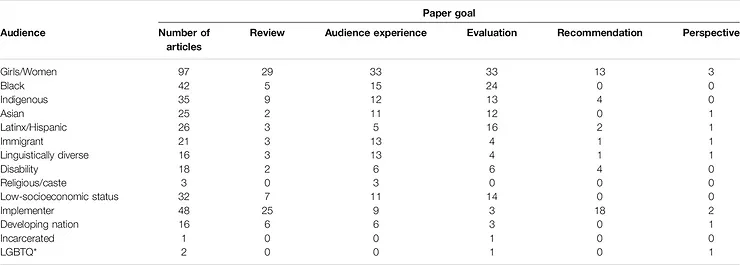Something old, but also new: Mapping 40 years of DEI SciComm research
By Niveen AbiGhannam
Title: A Systematic Map of Inclusion, Equity and Diversity in Science Communication Research: Do We Practice what We Preach?
Author(s) and Year: Karina Judd and Merryn McKinnon (2021)
Journal: Frontiers in Communication (open access)
| TL;DR: Although we have seen progress in empirical science communication research addressing DEI issues in the last 5 years, the discipline still has a long way to go before we can fully understand what constitutes inclusive science communication in theory and practice. A robust theoretical grounding is needed. Why I chose this paper: I am interested in how the science communication discipline can be more diverse and inclusive in theory and practice. This is one of the first papers that addresses this topic from a post-pandemic perspective. |
The COVID pandemic has shed the light on “pervasive inequalities” in relation to the communication of science and health information and the availability of services and resources to marginalized communities, especially in terms of gender and ethnicity. In the last decade, the science communication discipline has been nudged by multiple researchers calling out the “Western, white, ableist and patriarchal” approach most commonly used in communicating science, and the importance of reconfiguring this approach into one that is more inclusive and equitable.
In this paper, Judd and Mckinnon question the extent to which practitioners are capable of overcoming their own personal perspectives to lead truly inclusive scicomm approaches through an examination of 40 years of empirical evidence on how diversity and inclusion have been defined and implemented in science communication research and practice.
The Details
The authors employed a systematic mapping approach to survey existing evidence on how inclusive science communication has been defined and implemented in the past 40 years. Just like a systematic review of the literature, this approach surveys what evidence exists, but unlike review studies, mapping studies do not synthesize the results of many studies. Instead, they only focus on the context and purpose of the studies.
Searches were conducted of journal articles published between 1980 and 2020 in English using Web of Science and Scopus databases. The keywords used to search were intentionally left broad in order to yield a diverse body of literature, which is the purpose of this study (e.g. science communication; engagement; outreach; participation; etc.).
The search resulted in 5,455 unique articles. The authors then exported the articles into Rayyan, a web app designed to conduct collaborative systematic reviews, to filter the articles based on the abstracts and titles in order to make sure that they fit within their set parameters for their study (e.g. if the articles were not peer-reviewed, the dates did not match their criteria, if science communication meant communicating among researchers rather than with nonexperts [e.g. open access issues], etc.). The resulting corpus of 290 articles was read fully and further filtered down to 213 papers that were coded for this study.
The Results
Only 12 articles addressing DEI issues in science communication were published In the first 20 years of the sample (1980–2000). An additional 24 articles were published between 2001 and 2010, and 178 articles were published between 2011 and 2020, with the majority (n = 135) published between 2016 and 2020. These findings provide evidence that although the topic of inclusive science communication is not necessarily new, it has become more ubiquitous in recent years.
Most of these articles (n = 15) were published in the Journal of Science Communication (JCOM), Frontiers in Communication (n=11) and the Journal of Research in Science Teaching (n= 11), Science Communication (n=10), Science Education (n=10), and Public Understanding of Science (n=8).
Geographically, almost half of the sample (102 articles) was published in North America, while 14.5% came from Europe (31 articles), and 12.7% from various global regions (27 articles).
The audience groups targeted by the papers were mainly girls/ women (n=97). Forty-eight papers targeted other practitioners and/or researchers (implementers). The “under-represented minority groups” were mostly bundled together in papers, with the exception of Asian audiences that were less frequently included. Communities from low-socioeconomic areas were another main audience, especially in the UK. Very few papers looked at specific audience groups, namely those with disabilities (n = 18), developing countries (n = 16), religious or caste identities (n = 3), and those in prison (n = 1).
The most common goal that appeared in articles was to present the experience of an audience (n = 76) [e.g. informal learning]. Sixty-six articles outlined some form of evaluation (e.g. of mentoring programs, pedagogical approaches, workshops, etc.). A quarter of the articles were reviews of particular topics or issues by using existing datasets or literature corpus. Less than 10% of the articles focused on making recommendations, for example, for making spaces physically accessible, working with Indigenous community groups, etc. Table 1 below lists the distribution of audience groups across different paper goals.
Table 1: Comparison of audience and paper goals.


The authors also categorized articles by fields of research. STEM engagement was the largest category (65 articles), followed by science communication practice (62 articles). Science education was also equally represented with articles spread across higher education (23 articles), secondary (25 articles), and primary and early childhood education (22 articles). Science communication theory was much less represented with only six articles.
The Impact
Although it is encouraging to find that the topic of inclusive science communication has received heightened academic attention in the last 5 years especially, the authors caution about the disproportionate focus of such articles. Particularly, the authors found disparities in focusing on historically under-served and minoritized audiences. Additionally, empirical research is still not at a stage that enables it to “catalyse the societal, institutional and systemic changes” that are needed to inspire truly inclusive science communication theory and practice.
While individual existing work may be valuable to identify DEI issues relevant to science communication, the systematic map produced “does not show a coherent and comprehensive body of work.” In other words, the sampled literature in this study felt disconnected from one another and did not stem from a strong theoretical ground. The authors concluded that as a discipline, we are yet to have this robust evidence base, which is what we seem to need in order to understand “what constitutes best practice, for whom and how” in both theory and practice.
Edited by Kirsten Giesbrecht
Cover image credit: Godavari old and new bridges by Kalyan Kanuri

